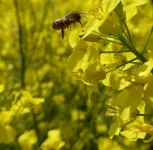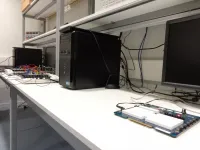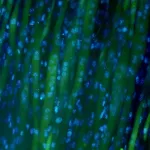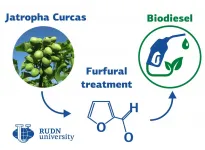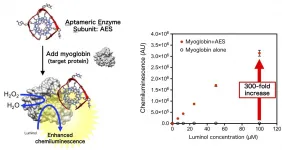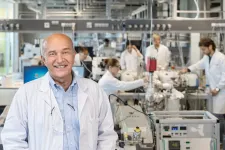(Press-News.org) Researchers have developed a more efficient platform for studying proteins that play a key role in regulating gene expression. The approach uses engineered yeast cells to produce enzyme and histone proteins, conduct biochemical assays internally, and then display the results.
"Biomedical and biotech researchers are interested in the mechanisms that allow histones to regulate gene activity," says Alison Waldman, first author of a paper on the work and a Ph.D. student at North Carolina State University. "But the conventional tools for histone research are unwieldy and slow. We wanted to develop something faster and less expensive - and we did."
In complex organisms, chromosomes are largely made up of DNA and a group of proteins called histones. These histones are important for packing the DNA into chromosomes properly, but also play a role in regulating gene expression. In other words, they help determine when and how specific genes are turned on or off.
One of the features that makes histones challenging to study is that they often have chemical modifications that, alone or in combination, alter the role the histone plays in gene expression.
"Histones essentially serve as docking sites for other proteins that influence gene expression, and the chemical modifications we see on histones play a role in determining which proteins have access to a given gene," says Balaji Rao, co-corresponding author of the paper and a professor of chemical and biomolecular engineering at NC State.
And to make matters more complicated, this is a dynamic process. A histone may have no modifications, it may retain a modification for the entire life of the cell, or modifications may be added and removed repeatedly. There is, in short, a lot going on. And enzymes are the catalysts responsible for all of those changes. Basically, enzymes are the mechanism for attaching or removing histone modifications.
So if you really want to understand what's going on with histones, you have to understand the chemical modifications. But if you want to understand the chemical modifications, you need to understand which enzymes are present and what they are doing.
Conventional methods for understanding how enzymes modify a histone involve using one of two techniques. First, you could use chemical synthesis to create enzymes and histone proteins, then conduct an assay in a test tube to see what happens. Second, you could genetically engineer one bacteria to produce an enzyme and engineer other bacteria to produce histone proteins, then harvest the relevant proteins, purify them, then conduct an assay to see what happens.
"Our technique uses a genetically modified yeast cell to produce both the enzyme and the histone," Waldman says. "The chemical modification takes place within the cell, and the resulting modified histone is sent to and displayed on the surface of the cell."
"In other words, the yeast cell makes the relevant proteins, does the assay for you, and then displays the result on top," says Albert Keung, co-corresponding author of the work and an assistant professor of chemical and biomolecular engineering at NC State.
The modified yeast platform is significantly faster than conventional techniques. For example, examining a single enzyme/histone pairing would take a couple days, instead of a week.
"But it's easier to scale up than existing techniques, so you would save substantially more time if you were looking at a lot of proteins," Keung says.
"In addition, there are some proteins that can't be made using chemical synthesis, or that can't be purified," Rao says. "Our technique doesn't require chemical synthesis or purification, which means we can look at proteins that were difficult or impossible to assay in the past."
The researchers demonstrated the utility of the technique by having engineered yeast cells produce two types of histones and a well-studied enzyme called p300, which adds a specific acetyl group modification to histones.
"We've shown that our technique works," Waldman says. "The next step is to begin expanding the modifications we're looking at and scaling up the process."
INFORMATION:
The paper, "Mapping the Residue Specificities of Epigenome Enzymes by Yeast Surface Display," is published in the journal Cell Chemical Biology. The work was done with support from the National Science Foundation, under grant 1830910; and the National Institutes of Health, under grant R21EB023377.
Mass-flowering crops such as oilseed rape or faba bean (also known as broad bean) provide valuable sources of food for bees, which, in turn, contribute to the pollination of both the crops and nearby wild plants when they visit. But not every arable crop that produces flowers is visited by the same bees. A team from the University of Göttingen and the Julius Kühn Institute (JKI) in Braunschweig has investigated how the habitat diversity of the agricultural landscape and the cultivation of different mass-flowering crops affect wild bees. The research shows that diverse agricultural landscapes increase the species richness ...
A team led by Skoltech professor Artem R. Oganov studied the structure and properties of ternary hydrides of lanthanum and yttrium and showed that alloying is an effective strategy for stabilizing otherwise unstable phases YH10 and LaH6, expected to be high-temperature superconductors. The research was published in the journal Materials Today.
Cuprates had long remained record-setters for high-temperature superconductivity until H3S was predicted in 2014. This unusual sulfur hydride was estimated to have high-temperature superconductivity at 191-204 K and was later obtained experimentally, setting a new record in superconductivity.
Following this discovery, many scientists turned to superhydrides, which are abnormally rich in hydrogen, and discovered new compounds that ...
Laboratories are an inherent part of technology qualifications, as practical experiments are essential for students to acquire the competencies and skills that they will need during their future professional development. Providing this learning in a virtual format is one of the challenges posed by the current COVID-19 pandemic--a challenge that distance universities have been addressing for years. RLAB-UOC is a remote laboratory designed and developed by the Universitat Oberta de Catalunya (UOC) that enables students in the Faculty of Computer Science, Multimedia and Telecommunications to conduct practical experiments with real electronic and communications equipment anywhere, at any time. A new article published in the scientific journal Electronics has described the characteristics ...
Near-death experiences are known from all parts of the world, various times and numerous cultural backgrounds. This universality suggests they may have a biological origin and purpose, but exactly what this could be has been largely unexplored.
A new study conducted jointly by the University of Copenhagen (Denmark) and the University of Liege (Belgium) and published in Brain Communications shows how near-death experiences in humans may have arisen from evolutionary mechanisms.
"Adhering to a preregistered protocol, we investigated the hypothesis that thanatosis is the evolutionary origin of near-death experiences", says Daniel Kondziella, a neurologist from Rigshospitalet, Copenhagen University Hospital.
When attacked by a predator, as a last resort defense mechanism, ...
An affordable lab system that uses grass blades to turn cells into cultured meat has been developed at the University of Bath in the UK.
Researchers have successfully taken grass from the university's campus and used it to create a scaffold that animal cells can attach to and grow on. The resulting tissue has the potential to be used both as lab-made meat and as human muscle tissue to repair or replace tissue which has been damaged or lost through injury or disease.
The study, by Dr Paul De Bank (Department of Pharmacy & Pharmacology), Professor Marianne Ellis (Department of Chemical Engineering) and Scott Allan (a PhD researcher in the Department of Chemical Engineering), is published in this month's Journal of ...
RUDN University chemists have proposed a new method of producing fuel from Jatropha Curcas, a poisonous tropical plant. Natural minerals and a non-toxic additive from vegetable raw materials are used for that. The reaction efficiency is 85%. The fuel can be used in diesel internal combustion engines. The results are published in the International Journal of Green Energy.
Jatropha Curcas is a common plant in many tropical regions. Its seeds contain lots of oil, but they cannot be used agriculture because the oil contains toxins that are dangerous for people and animals. But the composition of jatropha oil is suitable for the manufacture of biodiesel. One of challenge of the processing the plant raw materials is to select sufficiently ...
PROVIDENCE, R.I. [Brown University] -- Researchers from Brown University and MIT have developed a new data science framework that allows users to process data with the programming language Python -- without paying the "performance tax" normally associated with a user-friendly language.
The new framework, called Tuplex, is able to process data queries written in Python up to 90 times faster than industry-standard data systems like Apache Spark or Dask. The research team unveiled the system in research presented at SIGMOD 2021, a premier data processing conference, and have made the software freely available to all.
"Python is the primary programming language used by people doing data science," said Malte Schwarzkopf, an assistant professor of computer ...
A collaboration led by Distinguished Professor Dr. Kazunori Ikebukuro from Tokyo University of Agriculture and Technology (TUAT), Japan, discovered that G-quadruplex (G4)-forming DNA binds myoglobin through a parallel-type G4 structure. Through the G4 binding, the enzymatic activity of myoglobin increases over 300-fold compared to that of myoglobin alone (Figure). This finding indicates that DNA may work as a carrier of genetic information in living organisms and act as a regulator of unknown biological phenomena.
"Aptamers" are nucleic acid-based synthetic ligands that can be used against many target molecules with high affinity and specificity. Some aptamers that bind to proteins ...
Zeolites are extremely porous materials: Ten grams can have an internal surface area the size of a soccer field. Their cavities make them useful in catalyzing chemical reactions and thus saving energy. An international research team has now made new findings regarding the role of water molecules in these processes. One important application is the conversion of biomass into biofuel.
Fuel made from biomass is considered to be climate-neutral, although energy is still needed to produce it: The desired chemical reactions require high levels of temperature and pressure.
"If ...
WASHINGTON -- If you've ever tried to capture a sunset with your smartphone, you know that the colors don't always match what you see in real life. Researchers are coming closer to solving this problem with a new set of algorithms that make it possible to record and display color in digital images in a much more realistic fashion.
"When we see a beautiful scene, we want to record it and share it with others," said Min Qiu, leader of the Laboratory of Photonics and Instrumentation for Nano Technology (PAINT) at Westlake University in China. "But we don't want to see a digital photo or video with the wrong colors. Our new algorithms can help digital camera and electronic display developers better adapt their ...
